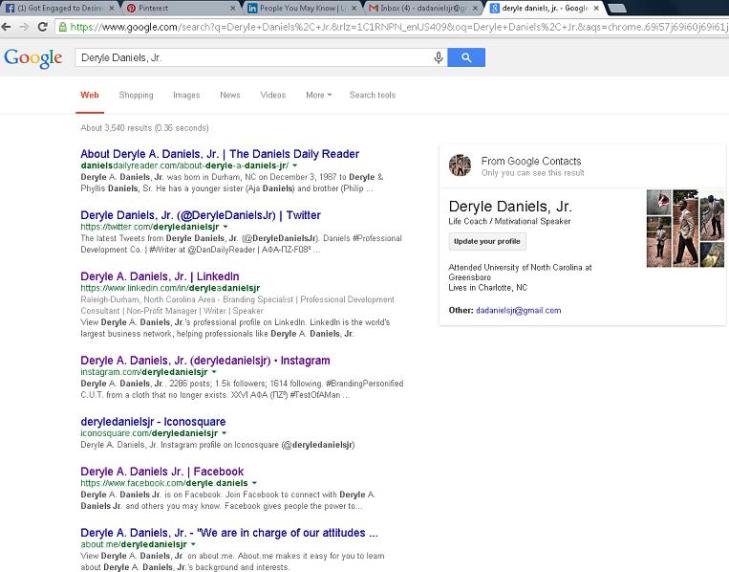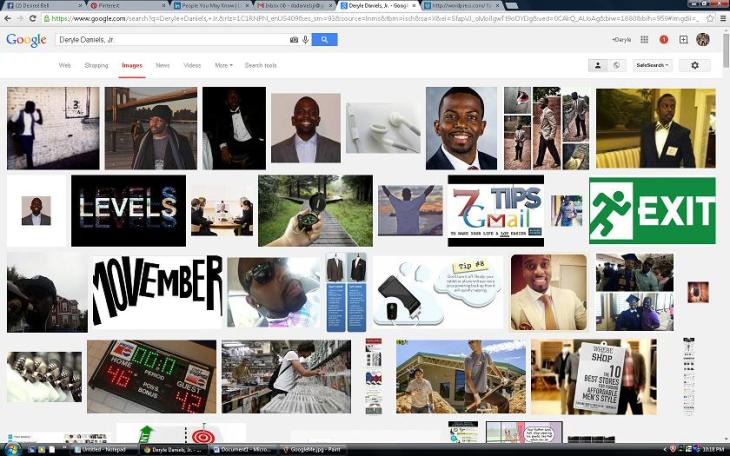Every time I get an opportunity to speak somewhere, I know that the group of students and/or young professionals I’m speaking with will search for me after I leave (if they’re not Googling me as I speak). And when I interview for a job, I know that the person interviewing me will likely do the same. So, in order to be proactive and protect my brand, I search for myself periodically. I make sure to take a look at the web results as well as the images associated with my name. What I don’t ever want to do is to be speaking to a group of students about professional development and a student raise his hand to ask me why there is a photograph of me passed out drunk or wearing a shirt with obscenities. See, my brand leaves room for me to have a drink or two from time to time. It even allows me to question the status quo as far as political issues go. But what you do not see when you search for me on Google is me swearing (with the exception of me directly quoting others). So, how do you establish an online presence? I’m glad you asked.
1) Formulate a plan of action
The coolest thing about the internet is that you can choose who you want to be. Of course some people take that too far (hence shows like Catfish). But really, the World Wide Web allows you to develop a persona that otherwise would not be possible. For me, I decided that I wanted to be recognized as a professional development consultant. Take some time to write out your goals and then decide how you can use the internet to leverage that brand. Social media is a great tool. I recommend toying around with Twitter, Facebook, and Instagram to begin with. Pinterest is also an awesome way to get your content discovered.
2) Clean all negative content off the first page of results
Most employers will not look past the first page of search results. And, those who do probably won’t look past the second page. So you have to get your name out there. The more positive content you have out, the more quickly the negatives will fall down in search results. So write, write, and then write some more. Post your material to your blog, message boards, LinkedIn, Facebook, Twitter, and other websites that are intended for sharing. Before you know it, people will have clicked on your positive content so much that any negatives you may have had will be on the fourth or fifth page of search results.
3) Write!
I said it before but I’ll say it again: Write. The better you get at writing about your subject matter, the more people will trust your judgment. The more they trust your judgment, the stronger your brand will get. Not to mention that the ability to write just might be what gets you noticed by the right people. My blogging has given me the opportunity to write for magazines, journals, and other blogs across the nation. The consistency of my posts has gotten me numerous speaking engagements. So, please write. You never know who will read it.
4) Make better decisions
I’m not big on New Year’s Resolutions. But, since it’s the first Monday of 2015, I will ask you to resolve to do one thing: Make better decisions. At a point in history where almost everything done outside one’s own home is recorded by one camera or another, your ability to make great decisions is what will keep your online presence intact. My father told me time and time again that it takes years to build a great reputation but one bad decision can ruin all that you’ve worked hard to build. So make a decision today to be intentional in everything you do. If you go out for drinks, do so with the knowledge that too many will land you on Instagram as a meme. If you tweet an offensive statement, just know that words are often misconstrued years later and, if you have any hopes at a corporate career in the future, that may be pulled out of the Twitter archives 15 years from now. For those of you who, like myself, are set on entrepreneurship and, therefore, believe they haven’t got anyone to answer to, how wrong you are. Poor word choices made by owners of major companies can cost them millions in revenue every year. So choose your words wisely. They will be what make or break your future.
Take my advice folks. I don’t know a lot but I know a few things and I know that how you are perceived is what is going to put you in a position to make your dreams come true. So protect your name. Enhance your brand. And Google me.




 By
By 
